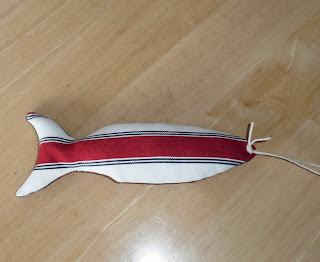These are quite simple, and although I use the sewing machine here they can be made by hand- there isn't a great deal of sewing involved.
You need-
Strips of fine or light weight fabric- I've used a cotton fabric.
fuse wire (or the fine wire used by florists in flower arranging)
plant sticks/canes ( thin green wooden sticks- found mine in B&Q)
Cut a strip of fabric 10 cm by 50cm and fold in half - bringing the long edges together and press along the fold.
Open the piece of fabric out and make a running stitch along the length using the pressed fold line as a guide.
Fold the fabric back along the pressed fold line.
Now to make the petal shapes- fold the fabric strip in half bringing the short edges together, you should end up with a folded piece measuring 25cm by 5cm. It is probably easiest to use a few pins to hold the fabric in place.
You can either draw the petal shape free hand or make a template.
Mark the shape on the fabric- ensure the you do this along the open edge of the fabric and not the fold!
Cut the petal shapes (reminder don't cut along the folded edge)- once done open out maintaining the fold on the long edge.
Again you may wish to use pins at this stage, stitch the two layers of fabric together, either with the machine or by hand, along the open edge of the 'petals' about 0.5cm from the edge.
Now to secure your flower to its stalk- the green garden canes. The ones I have are 25cm in length, and I've cut them in half. You can hide the cut end in the centre of the flower.
Thread a piece of fuse wire through the fabric strip bringing it out the other end a couple of centimetres, bend either end of wire to stop fabric coming off it, then draw up the running stitch.
Secure one end of the fuse wire to the end of the cane.
Then carefully start to form the flower head by wrapping the fabric strip round the top of the cane using the fuse wire to secure it.
It's a bit fiddly but it should hold in place if the wire is tight- take a bit of time here to shape the flower head. Once you reach the end secure using the wire.
Like previous projects you can modify this:
- change the dimensions of the fabric strips of create bigger/smaller flowers
-change the petal shape so you have more pointed petals or cut out using pinking shears
-instead of folding a strip of fabric use 2 long thinner strips of different fabrics sewn together, fold along the length of the seam.
-you can add leaves to the stems, again using wire to secure in place.























































